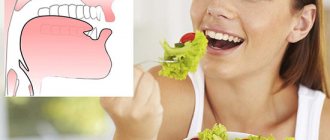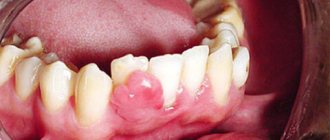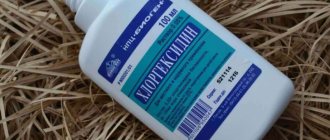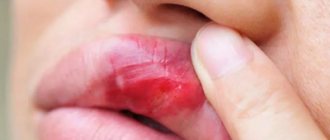Stomatitis can be recognized by multiple ulcers on the gums, tongue, palate, inner cheeks and lips. It all starts with redness, which is accompanied by a burning sensation or a slight tingling sensation, and only after that, in places where pathogens are most concentrated, an ulcer forms. As a rule, it is shallow, and nevertheless, at the slightest irritation - while eating or brushing teeth - it makes itself felt with severe pain. But don’t despair; with proper treatment, stomatitis can be defeated in 4-5 days. Chlorhexidine for stomatitis is one of the mouth rinses recommended by all doctors.
Where do bacteria come from in the mouth and how to fight them?
Whatever the type of stomatitis (and there are quite a few varieties of it - aphthous, allergic, herpetic, ulcerative), it is always accompanied by the active proliferation of bacteria or viruses on the mucous membrane. Do you think they come from outside, from dirty hands and unwashed fruit? But it turns out that even an absolutely healthy person’s mouth is always full of spirochetes, fungi, staphylococci, streptococci and other “cocci.” These cultures constantly interact and restrain the excessive development of one of their friendly company. This balance is also maintained by saliva, which allows the microflora to exist more or less normally, but not to multiply too actively. This is the normal microflora of the oral cavity, the task of which is to destroy “foreign” bacteria that enter the mouth from the outside.
And then overnight the balance of microorganisms is disrupted. There are too many of some, too few of others. This is stomatitis. It is not difficult to destroy harmony. This can be caused by many factors and is not always due to dirty hands or unwashed food. Inflammation of the mucous membrane can occur due to:
- colds;
- stress;
- injuries;
- taking antibiotics;
- hormonal surge;
- dehydration of the body, and, consequently, a significant decrease in the amount of saliva.
The presence of hard-to-reach places in the mouth that are difficult to penetrate with a toothbrush also significantly increases the risk of developing stomatitis. Carious cavities, gum pockets, leaky crowns - all these are ideal conditions for bacteria. You can’t get them there, so they begin to multiply beyond measure. The more tartar and plaque in your mouth, the higher the likelihood that you will sooner or later face the need to treat painful ulcers.
Precisely because with stomatitis you have to “tame” overly active bacteria, one of the mandatory components of treatment is an antiseptic. It doesn't have to be chlorhexidine. But since it is the most accessible and cheap, most often patients prefer to rinse their mouths with it. The essence of its action is simple: it penetrates inside the bacterial cell and prevents it from consuming oxygen, which naturally causes it to die immediately.
Which chlorhexidine to buy and how to prepare the solution?
Chlorhexidine is an aqueous solution of chlorhexidine digluconate. When you go to the pharmacy, you can see containers with different numbers on the label - 0.05%, 0.1%, 1%, 5% and 20%. They indicate the concentration of the active substance in the solution. For mouth and throat rinses, 0.05% chlorhexidine is always used. If you buy just this one, then you won’t need to breed anything. But if you have a 20% solution on hand, that’s not a problem either. 2 milliliters of concentrated solution per liter of warm boiled water - that’s 0.05% chlorhexidine.
Note! There is also an alcohol solution of chlorhexidine on sale, but under no circumstances should you rinse your mouth with it. This is a technical antiseptic that is most often used to disinfect medical instruments and hospital premises.
Interestingly, chlorhexidine bigluconate can be sold under different names. For example, dentists often prescribe Corsodil to their patients. This is the same solution, only produced and packaged abroad. Because of this, its price is exactly 10 times higher than its domestic analogue! Does this mean that with its help it will be possible to deal with bacteria faster and more effectively? Not at all.
Chlorhexidine bigluconate solution 0.5 mg/ml 100 ml
Name
Chlorhexidine bigluconate.
Description
Transparent, colorless or slightly yellowish liquid, odorless.
Main active ingredient
Release form
Solution for external use.
Dosage
0.05% 100 ml.
pharmachologic effect
An antiseptic with a pronounced bactericidal effect against gram-positive and gram-negative bacteria (does not affect acid-fast forms of the latter): Treponema pallidum, Chlamidia spp., Ureaplasma spp., Neisseria gonorrhoeae, Gardnerella vaginalis, Bacteroides fragilis, protozoa (Trichomonas vaginalis), microbial spores , viruses, fungi; has little effect on some species of Proteus and Pseudomonas. Chlorhexidine bigluconate is also active against treponemas, gonococci, and trichomonas. Retains activity (slightly reduced) in the presence of blood and pus. Cleanses and disinfects the skin without causing damage.
Indications for use
The drug is used for the prevention of sexually transmitted diseases (syphilis, gonorrhea, trichomoniasis, chlamydia, etc.). It is used for antiseptic treatment of wounds, abrasions and cracks, burns, for bacterial and fungal diseases of the skin and mucous membranes, incl. in urology, surgery, obstetrics and gynecology. In dentistry, it is used for rinsing the mouth in cases where compliance with hygiene rules is difficult, in the postoperative period after flap periodontal surgery, for washing periodontal pockets, fistulas, and abscess cavities. Since chlorhexidine bigluconate has a cytotoxic effect, the concentration of the rinse solution should not exceed 0.25 mg/ml.
Directions for use and doses
The drug is used in the form of irrigation, rinsing and application - 5-10 ml of solution is applied to the affected surface of the skin or mucous membranes with an exposure of 1-3 minutes 2-3 times a day (on a tampon or by irrigation). For the prevention of sexually transmitted diseases, the drug is effective if used no later than 2 hours after sexual intercourse. Used after urination: using a nozzle, insert into the urethra for men (2-3 ml), for women into the urethra (1-2 ml) and into the vagina (5-10 ml) and hold for 2-3 minutes. Treat the skin of the inner thighs, pubis, and genitals. After the procedure, it is not recommended to urinate for 2 hours. Complex treatment of urethritis and urethroprostatitis is carried out by injecting 2-3 ml of the drug into the urethra 1-2 times a day, the course is 10 days, procedures are prescribed every other day. The rinse solution is usually prescribed 2-3 times a day (for rinsing the mouth, the drug should be mixed with an equal amount of water).
Use during pregnancy and lactation
Use with caution in pregnant and lactating women due to the lack of data on experience with clinical use. Do not treat the surface of the mammary glands before feeding.
Precautionary measures
The bactericidal effect increases with increasing temperature. At temperatures above 100 °C, the drug is partially decomposed. Contact of hypochlorite bleaches on fabrics that have previously been in contact with chlorhexidine-containing products may cause brown stains. In patients with open traumatic brain injury, spinal cord injuries, or perforation of the eardrum, contact with the surface of the brain, meninges, and the cavity of the inner ear should be avoided. In case of contact with the mucous membranes of the eyes, they should be quickly and thoroughly rinsed with water. Concomitant use with iodine is not recommended. Use in children. The use of chlorhexidine solution (aqueous or alcoholic) in newborns as a skin antiseptic before invasive procedures is associated with a certain risk of developing a chemical burn. Based on spontaneous reporting and literature data, a higher risk of skin reactions has been identified in preterm neonates, particularly those born before 32 weeks of gestation, in whom chlorhexidine was used during the first two weeks of life. Before performing invasive procedures, it is necessary to remove all materials soaked in chlorhexidine: bandages, sheets, napkins, gowns, etc. Do not use excessive amounts of solution. The solution should not be allowed to accumulate in skin folds, under the patient’s body, or on materials that are in direct contact with the child’s skin. If an airtight dressing (occlusive dressing) is to be applied to skin that has previously been exposed to chlorhexidine, ensure that there is no excess chlorhexidine solution on the skin before applying the dressing. Use in elderly people. There are no data regarding the specifics of use in elderly patients.
Interaction with other drugs
Not compatible with detergents containing an anionic group (saponins, sodium lauryl sulfate, sodium carboxymethylcellulose). Concomitant use with iodine is not recommended. The presence of soap can inactivate chlorhexidine digluconate, so before using the drug, any remaining soap must be thoroughly rinsed off. Ethanol enhances the effectiveness of the drug.
Contraindications
Hypersensitivity, dermatitis, viral skin diseases, age up to 12 years. It is not recommended for use on large surface wounds.
Compound
A 40 ml bottle contains: active ingredient: chlorhexidine bigluconate (in the form of dezine (chlorhexidine bigluconate 20% solution)) – 20 mg; excipient: purified water – up to 40 ml. A 100 ml bottle contains: active ingredient: chlorhexidine bigluconate (in the form of dezine (chlorhexidine bigluconate 20% solution)) – 50 mg; excipient: purified water – up to 100 ml. A 200 ml bottle contains: active ingredient: chlorhexidine digluconate (in the form of dezine (chlorhexidine digluconate 20% solution)) – 100 mg; excipient: purified water – up to 200 ml.
Overdose
Cases of overdose with external use are unknown. When ingested, the drug is practically not absorbed, so systemic effects are unlikely. However, in case of accidental ingestion, gastric lavage is necessary. If necessary, carry out symptomatic therapy.
Side effect
Possible allergic reactions (skin rash), dryness and itching of the skin, dermatitis, photosensitivity, stickiness of the skin of the hands (within 3-5 minutes), chemical burns of newborns (frequency unknown). In the treatment of gingivitis – staining of tooth enamel, tartar deposits, taste disturbance. If any adverse reactions occur, including those not listed in these instructions, you should consult a doctor.
Storage conditions
Store at a temperature not exceeding 25 °C. Keep out of the reach of children.
Buy Chlorhexidine bigluk solution d/nar.prim.0.5 mg/ml fl 100 ml in the pharmacy
Price for Chlorhexidine bigluk solution d/nar.approx. 0.5 mg/ml fl 100 ml
Instructions for use for Chlorhexidine bigluk solution d/nar.approx. 0.5 mg/ml fl 100 ml
How to rinse your mouth with chlorhexidine for stomatitis?
Chlorhexidine for stomatitis is used in a course, the maximum duration of which is 10 days. All this time, rinsing should be given for two minutes in the morning and evening. It is better to do the treatment after breakfast and dinner, since the antiseptic needs time to act, and for this you will have to give up eating for at least 2 hours.
The scheme is not complicated: we had breakfast, brushed our teeth properly, rinsed our mouth with water again to get rid of any remaining toothpaste - some of its components can reduce the effectiveness of the drug, and started treating the mouth with an antiseptic. To do this, you need to take a small amount of 0.05% chlorhexidine solution into your mouth and rinse for at least a minute. This is an important condition, because only with prolonged rinsing does chlorhexidine bigluconate form a thin film on the surface of the mucous membrane, which will fight bacteria for several more hours. In the evening, the procedure must be repeated.
Note! Accidental ingestion of even a weak solution is fraught with serious consequences. If this happens, you should immediately rinse your stomach and consult a doctor.
It is for this reason that chlorhexidine is rarely prescribed for rinsing for childhood stomatitis - the risk of accidental ingestion is too high. However, for these purposes the drug is released in the form of a spray. It can be sprayed onto any areas of the mucous membrane where there are aphthae and inflammation, but you should avoid contact directly with the throat or tonsils.
As for pregnant and lactating women, the drug poses no danger to them. Chlorhexidine is not absorbed into the blood and is concentrated exclusively on the surface of the mucosa, which means it can be used by this group of patients without restrictions.
Nevertheless, the duration of the standard course of treatment - 10 days - of course, cannot be exceeded by anyone. There is a temporary limitation in the use of antiseptics for a reason. By suppressing the proliferation of some bacteria for too long and intensively, we thereby promote the growth of others, in particular the Candida fungus. Many women are familiar with it firsthand - the same fungus provokes thrush. Getting rid of it is not easy, and if the same infection settles in the mouth, a lot of unpleasant sensations are guaranteed.
It happens that the need for antiseptics does not disappear even after 10 days from the date of start of treatment, in which case you can choose a mouthwash based on extracts of medicinal plants that has a mild anti-inflammatory effect.
Chlorhexidine for stomatitis - proven effectiveness!
The main causes of stomatitis are dangerous bacteria and reduced immunity. In addition, it can be a consequence of mucosal injury, general intoxication, and even leukemia.
To treat stomatitis, doctors often prescribe chlorhexidine. How effective is it? We will consider the properties of this drug, indications and contraindications.
We will also find out how effective it is for stomatitis and how to use it correctly.
Properties of the drug
The first symptom of stomatitis is ulcers on the oral mucosa. They are painful and cause severe discomfort. Children often suffer from them. Kids refuse to eat, and sometimes even to communicate. A number of medications are used to combat stomatitis. Among them is chlorhexidine.
Among other drugs of similar action, chlorophyllipt should be noted. Chlorophyllipt for stomatitis is effective and safe. It is used for rinses and applications. An alcohol solution is used. Among folk remedies, baking soda is recommended for stomatitis.
Chlorhexidine is used for rinses and applications.
It can relieve inflammation, fight infection and promote healing of ulcers. You should consult your dentist regarding the use of any of these remedies. It is important to determine why stomatitis developed and prescribe treatment based on this.
Doctors prescribe chlorhexidine for stomatitis very often. Chlorhexidine (chlorhexidine bigluconate) is an antiseptic drug. It has the following properties:
- able to suppress microbial activity;
- fights fungus;
- effective against viruses.
The product suppresses the activity of three groups of pests at once, which cause many diseases.
The product is available in the form of a solution (alcoholic or aqueous), cream, gel, patch. To combat stomatitis, the drug is most often used in liquid form. This is due to the fact that it is used for regular rinsing. A gel may also be prescribed for application.
An effective analogue of Chlorhexidine.
Chlorhexidine is very often prescribed specifically for stomatitis. The powerful effect of the drug is due to the fact that it creates a protective film on the affected surface. It becomes a reliable protection for ulcers and inflammations from ubiquitous bacteria. Using the drug will significantly speed up healing. This has been proven by practicing dentists.
Can chlorhexidine be used to treat children?
As practice has shown, this drug is practically harmless. It is used in pediatrics. But when treating children, you should remember the following precautions:
- Do not allow your child to swallow the solution. If this does happen, you need to neutralize it as described in the instructions.
- Do not use the product for more than 12 days. Long-term use can lead to oral dysbiosis. This is highly undesirable and may require long-term treatment.
Important : There is a virus against which chlorhexidine is absolutely powerless. It's herpes. If it was he who provoked the development of stomatitis, then there is simply no point in using chlorhexidine to treat it. For herpetic stomatitis, other drugs are prescribed.
How effective is it?
Even after rinsing, it is still active in the fight against infection for a certain time.
To combat stomatitis, doctors prescribe chlorhexidine as a bactericidal and bacteriostatic drug. It is important that the doctor chooses the treatment regimen. He will prescribe exactly the form of the drug that will be most effective in a particular case of the disease. It should be remembered that there are different types of stomatitis. They are treated with different drugs. The concentration of the drug is also important.
To suppress the growth of bacteria, it is best to use a solution of chlorhexidine (0.01%). In some cases, a stronger concentration of the drug is used. It is used for rinsing.
Important : For rinsing to be effective, the temperature of the solution should not be lower than 22 degrees. It is the warm solution that is most effective. The duration of the procedure is 30-60 seconds.
But to combat the fungus, a drug concentration of 0.05% is prescribed. In this case, the solution should be at room temperature. The duration of the procedure is 10 minutes. To combat the virus, the drug is prescribed at a concentration of 1%.
This tool is truly universal. It is what dentists most often prescribe for the complex treatment of stomatitis. It is important that the doctor select exactly the concentration and form of the drug that will relieve inflammation in a particular case. The huge advantage of the drug is that even after rinsing it is still active in the fight against infection for a certain time.
How to rinse effectively?
Chlorhexidine perfectly cleanses the oral cavity from bacteria, viruses and fungi. The effectiveness of treatment largely depends on how correctly rinsing with the drug is carried out. In order for rinsing to bring maximum benefit, you should consider the following recommendations :
- There is no need to rush rinsing. First you need to brush your teeth thoroughly. It is best to complement this procedure with cleansing using dental floss. It will help remove food debris from between the teeth. Therefore, you need to rinse your mouth thoroughly. To do this, it is best to take boiled water. Only after such procedures can you begin to rinse.
- The 0.05% solution does not need to be diluted. You need to rinse for about 30 seconds. You should not swallow the solution. Chlorhexidine perfectly cleanses the oral cavity of bacteria, viruses and fungi.
For chlorhexidine rinses to have the desired effect, they must be performed at least three times a day.
Important Rules
In order for the disease to recede quickly, it is important to follow these rules :
- There is no need to continue rinsing for longer than half a minute.
- If after rinsing you begin to feel the taste differently, then do not be alarmed. This is normal and will pass soon.
- After rinsing, refrain from drinking or eating for several hours.
- If stomatitis is not in advanced form, you can limit yourself to rinsing twice a day. Rinsing three times a day is recommended for severe pain.
- Chlorhexidine solution can be combined with other drugs.
How to effectively treat stomatitis in a child?
For older children, rinsing is more suitable.
Children are more likely to suffer from stomatitis. Often these are children who have not yet reached three years of age. Their immunity is just developing and is not always able to cope with bacteria, viruses and fungi. It is these little ones who most often learn about the world through their mouths. They lick and chew everything that comes their way. At the same time, many microorganisms enter the mucous membrane.
Treatment of the mucous membrane in children under three years of age and infants is carried out using a sterile cotton swab. It is moistened in the preparation and all ulcers and areas of inflammation are carefully lubricated with the solution. The procedure is performed after meals 3-4 times a day.
For older children, rinsing is more suitable. As we already mentioned, before them you need to brush your teeth and rinse your mouth with water. The baby should take about a dessert spoon of the solution into his mouth. The procedure lasts about half a minute.
Important : Before rinsing, be sure to explain to your child that swallowing the solution is strictly forbidden! He must understand that this is medicine.
Treatment lasts on average about five days. The child may refuse such rinsing. The problem is that the drug has an unpleasant taste.
The product should be used with caution when treating pregnant women and children.
If a child swallows the solution, it is necessary to rinse it. Then you need to drink activated carbon (one tablet per 10 kg).
Contraindications
The use of the drug is contraindicated in the following cases:
- If the patient does not tolerate the composition of the drug.
- If other drugs (miramistin, hydrogen peroxide) are used in parallel for rinsing.
- The product should be used with caution when treating pregnant women and children.
Advantages and disadvantages of the drug
Due to its high antimicrobial activity, chlorhexidine is often used in dentistry. It is cheap and effective - these are its main advantages. But the coin also has a downside. In addition to the fact that rinsing is unlikely to give the patient a pleasant sensation (the solution has a pronounced bitter taste), they can also stain the teeth and tongue brown.
The fact is that blackening is a reaction of microbes to the active substance. Where the accumulation of microorganisms is most abundant, dark spots appear. However, you can easily get rid of them by making an appointment with your dentist for tartar cleaning. But even if this is not done, after a few days after completing the course of rinsing, the darkening will go away on its own.
It must be said that not all dentists prescribe chlorhexidine for stomatitis. Some doctors generally believe that the effectiveness of this drug in the treatment of ulcerative inflammation of the mucous membrane is zero. They argue their position by the fact that 9 out of 10 stomatitis are caused not by bacteria, but by viruses, in particular herpes viruses. And if chlorhexidine fights microbes with a bang, then it is practically powerless against viruses.
Of course, there is also an aphthous form of the disease, but it is usually the result of a local allergic reaction, vitamin deficiency or injury (burn, scratch, cut), and therefore it is not treated with antiseptics. They can be used for only one purpose - to prevent bacterial infection from joining the foci of erosions and ulcers. If we are talking about the herpetic form of stomatitis, then it is appropriate to use another antiseptic - Miramistin, which can affect not only bacteria, but also viruses.
So you shouldn’t place too much hope on recovery by doing just rinsing. Chlorhexidine is effective only as part of complex therapy and only after deposits of stones and plaque have been removed from the oral cavity. Treatment of stomatitis is often impossible without taking antihistamines and antifungals, and in some cases without antibiotics.
Dentists warn
By trying to suppress inflammation with an antiseptic, patients are doing themselves a disservice. Until the cause of the inflammation is determined and eliminated, it will develop one way or another, only with less pronounced symptoms. The result of such amateur efforts can be sad: when the patient does get to the doctor (and this is inevitable), the only way out of this situation may be the removal of loose teeth.
Note! Like any medical product, chlorhexidine has an expiration date. You cannot rinse your mouth with a solution that has been stored in your medicine cabinet for more than 2 years. Moreover, even if you are sure of the date, make sure that all this time the packaging was stored correctly (at a temperature not exceeding 25 degrees) and was not exposed to direct sunlight.
Symptoms of stomatitis
- soreness of the oral cavity;
- bad breath;
- formation of ulcers in the mouth;
- increased body temperature (in severe and widespread form).
At the initial stage of stomatitis, the oral mucosa dries out in the affected areas and becomes shiny. After 1–2 days, a barely noticeable white coating appears. At the next stage of stomatitis, ulcers appear, which are called aphthae. The chronic form of stomatitis is diagnosed when several pathological lesions form in the oral cavity more often than once a year.
When else is chlorhexidine used for teeth?
After tooth extraction
Stomatitis is not the only reason to resort to the help of an antiseptic. Its antimicrobial properties can be very useful after a complex tooth extraction. Especially if the surgical intervention took place against the background of inflammation or not all deposits of tartar and caries have been removed from the oral cavity. To prevent the infection from seeping into the hole formed at the site of the removed molar and causing the blood clot there to suppurate, the surgeon may recommend an antiseptic.
How to rinse your mouth with chlorhexidine after tooth extraction? Not too active and not too long. Simply hold the solution in your mouth for 20-30 seconds. The main thing is to prevent a blood clot from falling out of the hole. Then repeated bleeding may begin and the risk of inflammation will be too high.
In this case, we may be talking about another diagnosis - alveolitis. It also involves rinsing with an antiseptic, but only after the inflamed contents of the hole have been thoroughly cleaned of necrotic residues, washed and treated with a medicinal solution. All these manipulations are carried out by a surgeon and only he can give recommendations on further rinsing with chlorhexidine.
During teething
Chlorhexidine digluconate solution is often indispensable in dental practice. Thus, it helps relieve inflammation that occurs when wisdom teeth erupt. Until it is completely above the surface of the gum, some part of the molar is covered by the so-called “hood” - part of the mucous membrane that lies on the chewing surface. The space between the tooth and the hood is a favorite place for bacteria. It's warm, humid, and full of food debris that you can't reach with a toothbrush. It is not surprising that the mucous membrane becomes inflamed, swollen, and in some cases even purulent discharge is observed. Regular thorough rinsing with an antiseptic, as a rule, copes with this problem once or twice, and yet this is not a reason to self-medicate. A consultation with a doctor is necessary at least to make sure that the inflamed hood does not require any other intervention.
With flux
You cannot do without rinsing your mouth with chlorcesidine even after installing a drainage, which often happens if you use a flux. An opened purulent abscess is a huge threat to the entire oral cavity. This is a real source of microbes and bacteria that can spread a purulent infection not only throughout the entire mucous membrane, but also reach the tonsils. In this case, rinsing with chlorhexidine should be done very carefully so that the drainage does not fall out. It is enough to put the solution in your mouth and hold it there for half a minute.
For bleeding gums
An antiseptic can also help in the treatment of inflammatory processes in the gums caused by accumulations of soft plaque and tartar. It will quickly deal with the bacteria remaining after professional teeth cleaning (without this, alas, nowhere, otherwise the effect of chlorhexidine will be short-lived and inflammation will soon begin with even greater force). In addition, various forms of gingivitis and periodontitis are perfectly treatable with the help of special chlorhexidine toothpastes.
As you can see, chlorhexidine solution in dentistry in general and for stomatitis in particular is an irreplaceable remedy. But it, like any potent medical drug, can cause serious harm to health if you do not adhere to strict rules for its use. By self-medicating, the balance of the microflora of the oral cavity can easily be disrupted, but it will definitely not be possible to restore it without the help of a dentist.
Sources used:
- Hygienic care for inflamed periodontal disease / S.B. Ulitovsky. - M.: MEDpress-inform, 2008.
- Etiology and pathogenesis of inflammatory periodontal diseases / E.V. Fomenko. — M.: Medical Information Agency (MIA), 2010
- Chlorhexidine. State register of medicines (May 26, 2016).
Disease prevention
To prevent the disease from developing or becoming chronic, it is necessary to keep your mouth clean, eat well, and give up smoking and other bad habits. It is important to promptly treat other oral diseases, such as periodontitis, gingivitis, glossitis, caries. If you suffer from chronic stomatitis, regular visits to the dentist are recommended. It is necessary to pay attention to the general condition of the body, monitor the state of the gastrointestinal tract and cardiovascular system, take vitamin complexes, get adequate sleep and lead an active lifestyle. As a preventative measure, you can rinse your mouth with a decoction of chamomile or sage, as well as warm saline solution.








